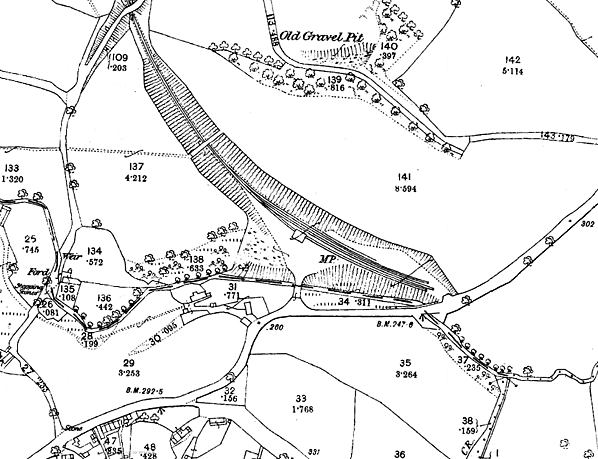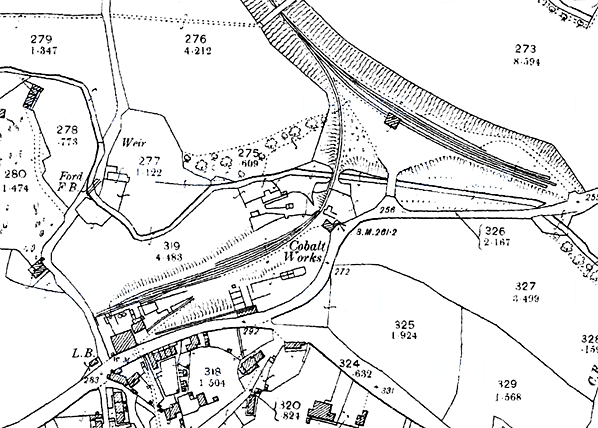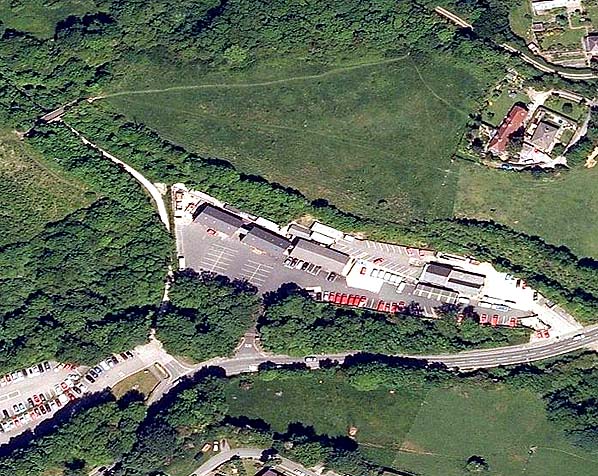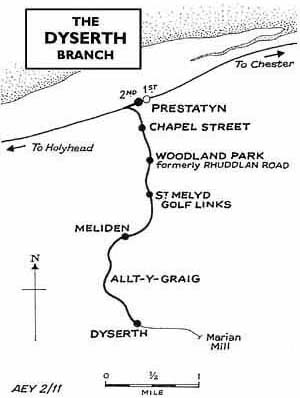
Station Name: DYSERTH [Source: Paul Wright]
old20.jpg) Dyserth station was served by a ‘railmotor’ between 1905 and 1919. In this view the railmotor waits outside Dyserth station as railway staff pose for the photographer in the first decade of the 20th century. The line from Dyserth Quarry works comes in from the right.
Photo from John Mann collection  
1872 1:2,500 OS map. At this time Dyserth was a goods-only station; the goods shed can be seen in the centre of the map. Although Dyserth Quarry was operating at this time, the siding to the quarry works had not yet been laid.

1899 1:2,500 OS map. A siding has now been laid to the newly-built quarry works and transhipment point on the north side of High Street. There is now a rail connection between the siding and the quarry to the south of the village.
 1912 1:2,500 OS map. Dyserth station is now open for passengers. The southern siding has been shortened to accommodate the passenger platform. The booking office is seen just to the east of the truncated siding. There is a narrow-gauge rail connection across High Street to Dyserth Quarry.

1961 1:2,500 OS map. The station has now closed to passengers and is once again just a goods station. Note the addition of the Co-op Vale of Clwyd Farmers’ warehouse near the end of the line on the north side of the sidings.
old3.jpg)
During the Great War of 1914 to 1918 two ladies from the Volunteer Aid Detachment (VAD) wait to board a train at Dyserth station. Well educated women who were living at home were typical VAD volunteers. They learned skills such as nursing and driving so that they could help the war effort. The women in the picture are likely to be Gwyneth Kermode and a Miss Roberts, a captain and a lieutenant of the Prestatyn Girl Guides.
Photo from John Mann collection, information from www.dyserth.com web site old6.jpg)
The passenger station at Dyserth in 1950. Tickets were issued from the window that can be seen boarded-up next to the door; the building was also a general store. Another wooden hut was used as a waiting room and toilet, perhaps the hut seen on the far left. The goods shed on the right dates from the opening of the line in 1869.
Copyright photo from John Alsop collection
old7.jpg) Dyserth Station from the buffer stops in April 1950. The passenger station can be seen to the left of the picture; it was nothing more than a low platform and a simple wooden hut. The building on the right is the Co-op Vale of Clwyd Farmers’ warehouse.
Copyright photo from John Alsop collection old14.jpg)
Looking north-east at Dyserth station in July 1963. The station booking office can be seen to the left. A stone train from Dyserth Quarry waits in the siding. The quarry siding runs behind the goods shed.
Copyright photo by R M Casserley old10.jpg)
The ‘Welshman Railtour’ in the sidings at Dyserth on 22 March 1963.
Photo from Courtney Haydon collection old15.jpg)
Looking south-east at Dyserth Station in December 1972. The passenger station can be seen to the right. The low platform had been removed by this date. To the left, behind the mineral wagons, the Co-op Vale of Clwyd Farmers’ warehouse can be seen. Regular daily stone trains continued to work from the station at this time.
Photo from John Mann collection 1.jpg) Dyserth Station looking north-west in October 1979. The wooden passenger station building was still standing after nearly 50 years of closure. The sidings at the station had seen regular rail traffic until 1973, and, although the track is still in place, it is heavily overgrown and not visible. At this time the quarry line running behind the goods shed still saw occasional traffic; it was not lifted until 1980.
Photo by John Mann 
Aerial view of the station site in the mid-2000s. The railway path can be seen coming in from the top left, passing under a bridge. As it approaches the station it is diverted to the south along the old quarry siding to reach the road. The old goods shed crane has been relocated to this point as a feature of interest. A short approach road to the station forecourt can be seen below the yard. At the end of the approach road the goods shed was straight ahead, and the booking office was to the right. A small private housing development (Anglia House) has now been built at the end of the approach. The Co-op Vale of Clwyd Farmers’ warehouse (the only railway-related building still standing) is seen to the right, near the road.
8.jpg) Looking north-west at the site of Dyserth station in November 2010 from a similar viewpoint to the April 1950 picture. The photographer is standing at a point which would have been the very end of the line. The building to the right, behind the garages, is the Co-op Vale of Clwyd Farmers’ warehouse. The site of the passenger facilities is immediately beyond the buildings. Trains operated to this location until 1973. Photo by Paul Wright
|





 Home Page
Home Page